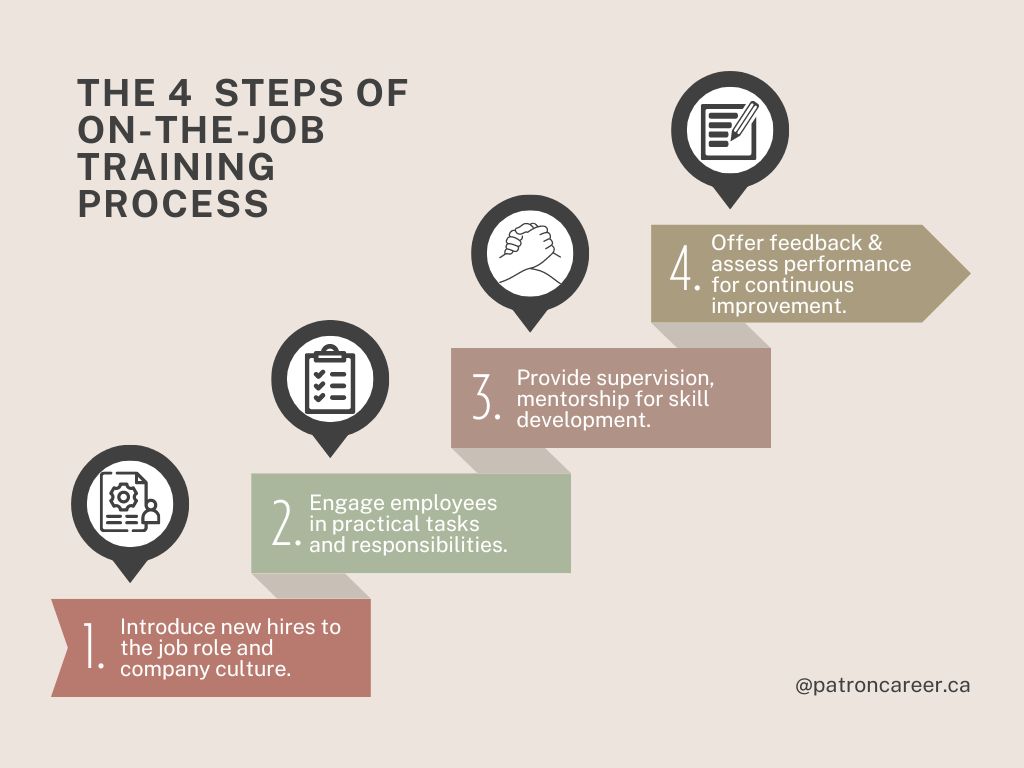
Employee Relations
3 June, 2024
Patron Career Staffing firmly believes in adopting a tailored approach to meet temporary and permanent recruitment needs. We safeguard the interest of our clients by finding such workers who are knowledgeable and reliable.
About UsNeed help? Make a Call
32 Dundas Street East Unit A, L5A1W2

Josie is a new hire at a swarming retail company stepping into the store manager role. On her first day at work , she spent shadowing her supervisory manager who elucidates her about inventory management, customer relations, and staff scheduling. She is excited about participating in real-time problem-solving during peak hours and is engrossed in team meetings to infer the store’s operations. This firsthand experience is her gateway to what we call on-the-job training (OJT), a primary component of workforce development.
For learning and development (L&D) teams, providing experiential learning to employees is of paramount importance, as it's associated with more growth and ultimately the success of companies. Read ahead to know- what is OJT, why it is beneficial and 4 actionable practices for conducting OJT excellently.
What does On-the-Job Training (OJT) mean?
A methodical learning experience ensues when new employees are hired or existing ones acquire skills that are later put into practice. Deficiencies in traditional training such as lack of real-world application, and immediate relevance to job tasks are met effectively by on- the-job training. OJT is far from classroom-based learning, instead, it focuses on practical skill accumulation within the work settings and eradicates the need for devoting drawn-out sessions and seminars (or so webinars!)
Career growth varies from person to person. It is never a blanket approach; it manifests differently for everyone. Here’s an example. For an employee, it might mean reaching a managerial position from a lower role or taking on challenging projects, to depict conviction and rise to become a steadfast leader of their team. Whatever the goal, career growth requires one to be continuous and unwavering in their efforts while staying relevant in the ever-evolving job market.
On-the-Job Vs. Off-the-Job Training Methods: What's the Difference?
Top 3 OJT Methods to Upskill Your Workforce
1. Job Shadowing
A method involving new employees being paired with experienced colleagues to observe and understand tasks at hand, workflows, and company culture. It aims to give new hires a clear understanding of job expectations and allows them to learn how to overcome challenges. The supervisor is responsible for the prolonged success of their trainee.
2. Job Rotation
This training method is all about employees rotating or switching between different roles or departments to develop a diverse skill set. Roles that require versatility and cross-functional knowledge often include job rotation in their employee training methods. Job rotation is useful for jobs such as Healthcare, IT, Management Trainee Programs, Engineering and Human Resources.
3. Hands-on Projects
Hands-on projects involve assigning real-world tasks to employees that directly contribute to the company’s objectives. This method allows employees to apply their knowledge and skills in a practical context, driving immediate value. Working on projects, fosters team spirit and a sense of accomplishment among members.

4 Actionable Practices You Can Employ to Conduct OJT
Learnt the best approaches to bringing on-the-job training into your workplace:
1. Integrated Simulation Exercises
Employees absorb knowledge best through integrated simulation. When training someone, it's important to guide them about what they might encounter and how to handle those ordeals with utmost fervour. You can incorporate integrated simulation exercises that replicate real-life scenarios employees are likely to come across. These are immersive experiences of practical situations by which your workforce can apply theoretical knowledge in a controlled environment.
For instance, in the healthcare sector, it’s important to train staff against any emergency scenarios or nurses may be given training to handle and respond to critical patient conditions. This method is aimed at providing training to bolster confidence in employees and preparedness to handle actual situations. L&D teams can further enhance learning outcomes by checking in with trainees during and after training.
2. Peer Collaboration and Team Projects
This method is backed up by the adage “Teamwork: Together Everyone Achieves More.” That is especially needed in a workplace that houses a variety of employees with different skills, and creativity. By giving them a supportive platform for learning, employee relations improve and workforce conflicts condense. This practice involves teaming up a group of employees for a project to gain individual insights for a shared objective.
Let's take the example of a software development team. The junior developers are assigned the task of creating a new mobile feature for the company’s website alongside senior developers who are far more experienced. This teaming up allows each of them to bring their own unique skill sets to the table and fosters more innovation for the project's success.
Also Read: A Guide to Expert Team Performance Management
3. Tailored Learning Paths
It can be highly beneficial to personalize the training material for each employee involved as per the goals and needs of employees and the organization alike. OJT is a one-to-one training system which involves current skill assessment of the employee and identifying their areas of improvement. The very first step is to recognize the employee’s strengths, interests, skills and weaknesses and customize the training material accordingly for better learning outcomes right away. This eradicates confusion and builds technical know-how of the task at hand.
For instance, a sales employee may lack in customer service, so providing him with personalized additional training on customer relations management and grievance handling.
4. Technology-Enhanced Learning Tools
In today’s tech-driven world, training is incomplete without digital training materials. Technology-enhanced tools are a must-have for enriching OJT experiences. These are go-to resources that save time, prevent distractions from work and improve employee retention. To offer employees a great learning experience, give interactive, multimedia resources and self-paced learning opportunities. Virtual simulations, online tutorials, and mobile learning applications enable flexible access to training materials anytime, anywhere, catering to diverse learning styles and preferences.
Let's say employees in a manufacturing plant undertake virtual reality (VR) simulations to practice safety protocols and equipment operations. It augments their proficiency in tasks and boosts trainee’s confidence in handling complex machinery.

Going the Extra Mile in Training Employees is Worth It!
There are tons of advantages associated with OJT of employees- enhanced skills and productivity, higher morale and retention, especially fostering career growth of employees. Alongside implementing these best practices in training, companies should get insights from employees about what they think of the training programs and how they are faring with them. The process is incomplete without timely feedback from both the trainer and the trainee. Finding ways to empower employees through effective and improved training protocols might be difficult, but never pointless. Inspire learning and drive engagement: start training!
Subscribe to our weekly newsletter and stay up to date with the latest HR news, trends, and job offers.
